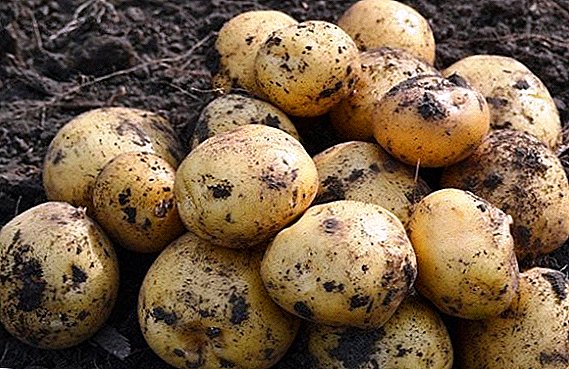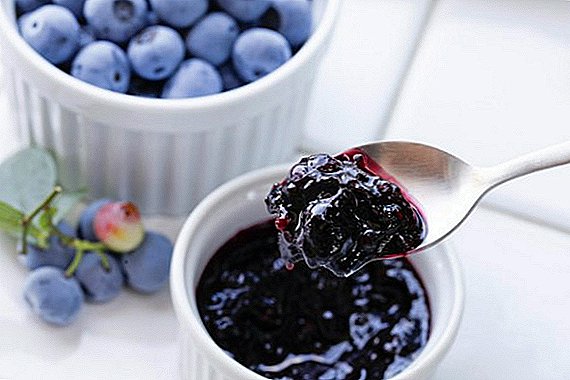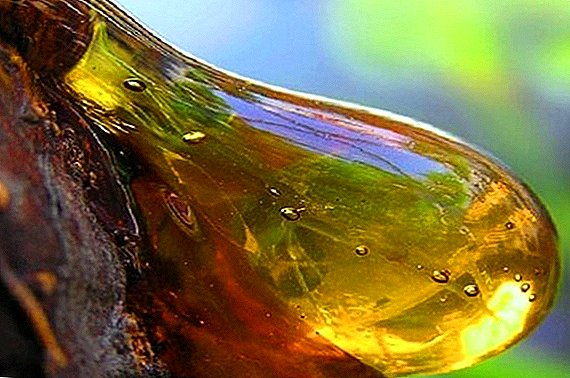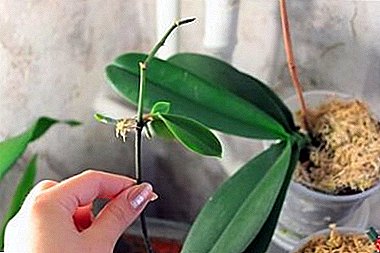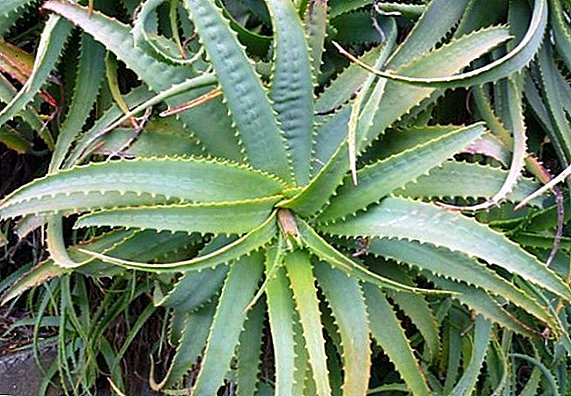 Long since the plant aloe tree endowed people with longevity and good health. The first news of him found in the holy books. So far, the plant has not lost its power and importance for humans.
Long since the plant aloe tree endowed people with longevity and good health. The first news of him found in the holy books. So far, the plant has not lost its power and importance for humans.
Botanical description
Aloe tree belongs to the family Xantoric. The botanical references are listed as Aloe arborescens. The name Agave is widespread among the people. It is a perennial evergreen, a plant growing in the tropics. It has juicy, large leaves, strongly elongated in the form of a sword, with sharp teeth along the edges. When flowering forms beautiful inflorescences of flowers in the form of bells of red and yellow shades.

The fruits of aloe tree are called boxes, filled with a considerable number of seeds. Aloe, grown at home, not more than a meter in height, not happy with flowers and does not give fruit. In exceptional cases, may bloom in early spring or late winter.
Read also what features of planting, care and watering aloe
Spread in nature
In its homeland - in South Africa is wild. Currently, it can be found in many tropical and temperate zones of our planet. In its natural habitat it grows up to 4 meters in height and has a 30 cm thickness of the trunk. In our latitudes, it is common as a home plant. In the Caucasus, planted aloe plantations for the needs of the pharmaceutical industry.

Chemical composition
For medical preparations, leaves are cut off at the very base. Fresh juice is squeezed out of them or processed by the method of thickening and a powder (sabur) is obtained. The composition of aloe tree is rich in vitamins, enzymes, phytoncides, essential oils and resinous substances, organic acids, including citric, malic and succinic. There are vitamins C, E and group B, beta-carotene, micro-and macronutrients.
Did you know? The quantitative composition of the mineral salts of the juice of a wonderful plant is equal to their amount in human serum.
Medicinal properties
The flesh of the leaves tastes bitter and has a faint odor. Fresh juice, its aqueous and alcoholic solutions have a bactericidal effect and kill a number of microbes, staphylococci, streptococci, dysentery, typhoid, diphtheria sticks. Anti-inflammatory effect is caused by the presence of salicylic acid, the laxative - by the presence of anthraquinone, choleretic - zinc and selenium.

Aloe preparations enhance the secretion of digestive glands, improve appetite and digestion, and also have anti-burn properties. High their effectiveness in the treatment of eye diseases and diseases of the gastrointestinal tract. And allantoin makes aloe indispensable for manufacturers of cosmetics, as this substance has a powerful moisturizing effect.
Aloe, honey, celandine, goldenrod, Jerusalem artichoke, watercress, yucca, calendula, linden, double-leaved, and dodder also help in the treatment of the gastrointestinal tract.
The use of aloe in traditional medicine
Even healers of Egypt, Rome, Greece treated skin diseases, painful conditions of the lungs, larynx, purulent eye abscesses with the juice of a miraculous plant. Modern herbal medicine advises aloe:

- with constipation as a laxative;
- as a general tonic;
- for the treatment of burns, depriving, of a boil, long-lasting wounds;
- with gastritis, ulcers;
- for recovery from cough, bronchitis, pneumonia, tuberculosis;
- with conjunctivitis of the eyes;
- in the case of infectious diseases of the female urogenital system;
- in violation of the sexual functions of men;
- as an analgesic for headaches and neurosis of various origins.
As a fortifying agent also used: primrose, prince, thorns, small basil, lily of the valley, wild garlic, caraway, dried kelp, nasturtium
Application in cosmetology
In cosmetology, the aloe tree plant has found such wide application that it is comparable with the use in medicine. The use of agave in cosmetology is determined by its following properties:

- anti-inflammatory and bactericidal (acne, rash, acne);
- regenerating and healing (wounds, cracks, skin rejuvenation);
- tonic and moisturizing (resilience and elasticity);
- soothing (irritation of the skin);
- antifungal (dandruff and other skin damage caused by fungi).
It will be useful for girls to learn how to use rosemary, marjoram, coltsfoot, dandelions, marigolds, chamomile, peony, nettles, lovage, enoteru, periwinkle, bird cherry, parsnip, zucchini, walnuts, beeswax for cosmetic purposes.
Harmful properties
When ingestion can occur heartburn, diarrhea, pain in the abdomen, increased bleeding, heaviness in the pelvic region. Allergic reaction is possible with external and internal use. With prolonged treatment is likely to decrease potassium, which is bad for the cardiovascular system.
Important! As the strongest biostimulator, it can provoke bleeding, the release of bile, inflammation of the colon.
Contraindications
Products containing aloe are dangerous in the following cases:

- With increased tendency to diarrhea.
- Women experiencing heavy bleeding and bleeding of the uterus.
- Persons suffering from acute diseases of the kidneys, bladder.
- People who have gallstone disease (accelerates the output of stones).
- Allergy prone patients.
- Patients suffering from hemorrhoidal bleeding, inflammation of the colon.
- People older than forty years.
- Persons with severe cardiovascular pathologies.
- With prostate.
- Pregnant, as it increases the tone of the uterus.
Important! It is strictly forbidden to wash the eyes with not diluted juice.
Growing at home
Aloe vera, grown at home, does not require special care for the content. Do not forget to periodically water, loosen the ground and apply fertilizer.

Sowing seeds
The best time for seed germination is March and April. To do this, take one part of the sand and sod and ½ of the leafy ground, distribute evenly and sow the seeds. Periodic watering is recommended as the soil dries. Sprouted seeds are distributed one by one into forms 5 cm high. The soil should consist of ½ part of sand and one part of sod and leaf mixture. Adding brick chips and charcoal will not interfere. A year later, an adult aloe transplanted.
Learn how to grow plants such as: juniper, lavender, rosemary, savory, fern Asplenium, room thuja, coffee tree, azalea, kalanchoe, anthurium, geranium, orchid, spathiphyllum, violet, begonia at home.
Location and lighting
In winter, agave is desirable to put near the sunny window. In the summer, you can take out on the sun terrace or balcony. Do not damage and sunbathing in the fresh air.
Temperature
In winter, the most suitable temperature will be 12-14 degrees. Since the growth and life functions of this species slow down, too warm a place will bring harm.

Soil and fertilizer
Aloe houseplant grows well in soil of charcoal and brick chips. The soil requires fertilizer only from May to August only once a month. Preference is given to complex feeding for succulents. Fertilizers should not be applied in the following cases: during the winter dormancy of the plant, if it has just been bought or transplanted (only after a month), diseased (the cause of the disease is not clear), with a rotting root system, in dry soil (moisten the soil before application).
Did you know? Aloe tree is extremely profitable to plant at home. It inhibits the maturation of a number of pathogens.
Humidity and watering
In winter, watering the plants should be limited to once a month. Too warm place of maintenance and frequent watering threaten rotting roots. In the summer, they moisten the ground as soon as the topsoil is dry. In the leaves of agave a lot of moisture. If you have forgotten, left for some time and have not watered, the agave will survive, because he is from Africa.

Transfer
Young plants of aloe tree need to be transplanted every year. If the plant is five years old, it gets old status. Now it needs to be replanted after three years. Aloe of this species can be propagated by seeds, leaves, cuttings, root processes.
Reproduction by cuttings
Although reproduction is possible by cuttings all year round, Still, preference is given to spring and summer months. Cut cuttings dried for two days. Cut the ground sprinkled with powdered charcoal. Raw sand - the best place of the first landing (at a centimeter depth). On the seventh day of the formation of the root system comes the time of the second landing in the prepared forms 7 cm high. The soil should consist of equal parts of sod, sand, leafy ground. Does not require excessive watering.
Also propagated by cuttings: petunia, chrysanthemum, pelargonium, azalea, clematis, brugmancia, tui, laurel, cornel, mulberry
Recipes
Recipes great variety. Consider the most popular.

For strengthening and growth of hair, at loss
- Hair loss. Rub a mixture of a tablespoon of juice, a teaspoon of honey and olive oil into the skin. Wrap for 30 minutes. Wash your hair with shampoo. Repeat once a week. The exposure period is three months.
- Revitalizing hair growth. Mix one tablespoon of agave juice with a teaspoon of honey and the same portion of mustard powder. Add egg yolk. Carefully whip the mixture into the roots. Leave for half an hour. Remove residue with running warm water.
For beauty hair
- Dandruff. Prepare a mixture of two tablespoons of aloe tree juice and a teaspoon of lemon juice, castor oil, honey. Heat in a water bath to a pleasant temperature. Apply to the roots and keep for half an hour. Wash off.

For the beauty of the face
- Tired skin and wrinkles. Grind two leaves of aloe and cover with water for a day. Strain, pour into molds and put in the freezer. Use for moisturizing.
- Acne. Wash gauze napkin with fresh agave juice. Leave the mask for 30 minutes. Wash off. Do it every day, later on every other day, then twice a week. 25 masks enough for a course of medical procedures.
As face masks they also use: prickly pear oil, honey, rose, fresh cucumbers, bee pollen, mountain ash red, gravilat, melon, curly lily, viburnum.
For the treatment of tuberculosis and pneumonia
- Beat honey, cocoa, butter (take 100 g each ingredient). Add 15 g of agave juice. Drink one tablespoon three times a day.
- A tablespoon of birch buds insist on a glass of juice, a glass of honey, a glass of Cahors 9 days. Tablespoon to drink three times a day.

For the treatment of angina, bronchitis and colds
- Bronchitis. Melted honey and butter mixed with juice. Products measure with one spoon in equal quantities. Give two teaspoons before meals four times a day. The course is 5 days. Stop taking. The next course to resume in five days.
- Angina. The juice is diluted with water 1: 1 and used for gargling, mouth.
- Respiratory infections. Drink a teaspoon of fresh juice before meals (for 20 minutes) three times a day.
For skin diseases
For various injuries and skin diseases (purulent wounds, trophic ulcers, burns, eczema, etc.), compresses are used based on the sap of a tree plant. There are recipes where there is another component - butter.
Healing wounds and burns are caused by canuper grass, maple sap, St. John's wort, anise lofant, large stonecrop, rutabaga, northern bedwalker, white willow, hazelnut, veronica officinalis, pine nuts, burdock root.
When furunculosis with a composition of olive oil and juice in equal parts wetted fabric. Apply on the boil and leave for a day. Change to a fresh lotion. Do to the disappearance of pain and inflammation.

For eye diseases
Pulp without skin and sharp teeth pour hot water 1: 5. The resulting solution at room temperature, clear the eyes, put a wet napkin over the eyes.
For diseases of the oral cavity
Rinse the mouth with a mixture of water and juice in equal amounts.
Urogenital Diseases
- Urinary tract infections. A mixture of a tablespoon of aloe juice and turmeric (at the tip of the knife) diluted with a liter of boiled water in the form of heat. Syringe vagina as often as possible. The healing period is two to four weeks.
- Uterine fibroma. In a water bath, evaporate 200 g of finely chopped leaves, one chestnut fruit, three glasses of red grape wine (30 minutes). Strain. Give a tablespoon three times a day, half an hour before meals.

- Tumor of the uterus. Identical parts of aloe juice, corn oil, black radish juice mix well. Pour in 70% alcohol (half a liter of the mixture 50 ml of alcohol). Insist week in a dark place. Give 20 minutes before meals. Take a tablespoon three times a day.
Other plants also have medicinal properties, such as lungwort, laconosa, savory, white silverweed, marsh wild rosemary, peppermint, anise, and cholstyanka.
Diseases of the stomach and intestines
- Ulcerative colitis. Drink juice twice a day, 25-50 ml.
- Gastritis. Half an hour before meals to drink a teaspoon of juice. Reception is designed for two months.
- Colitis and constipation. Give a teaspoon of juice before eating.
- A stomach ulcer. A mixture of half a glass of chopped agave leaves and honey (3/4 cup) is put in darkness for three days. After the time, pour in a glass of Cahors. After a day to filter. Take a tablespoon three times daily before meals.

Diseases of the cardiovascular system
- Hypertension. A teaspoon of water diluted with three drops of fresh juice. Give the patient an empty stomach for two months in a row.
- Stroke. Aloe juice (3/4 cup) mixed with 5 g mummy. In the early morning and late evening drink a teaspoon for two weeks. The course of treatment is interrupted. For the next two weeks, take propolis tincture three times a day, half an hour before meals, with 30 drops. The course of healing juice of aloe and mummy continue again for two weeks. The alternation lasts no more than two months.
In addition to the aloe tree, a positive effect on the state of the cardiovascular system is also exerted by the silverweed, hellebore, mountain arnica, oregano (oregano), chervil, rocambol, lohovina, hops, oxalis and buttercups.
For diseases of the joints
With arthritis, a compress from a mixture of three tablespoons of juice, six tablespoons of honey, nine tablespoons of vodka is placed on a sore spot and held for a while.

As you can see, the scope of the use of aloe multifaceted. This magical plant is truly a storehouse of nutrients. Using it wisely will only benefit your body.





